The 1937 Plymouth Deluxe stands as a testament to American resilience and innovation, emerging from the depths of the Great Depression as a symbol of hope and progress. This iconic automobile, with its sleek design and advanced features, not only captured the hearts of a nation yearning for a brighter future but also played a pivotal role in reshaping the automotive landscape.
The Plymouth Deluxe, a product of the Chrysler Corporation, was meticulously engineered to offer a blend of affordability, style, and performance. It was a departure from the austere automobiles of the Depression era, showcasing a newfound optimism and a desire for a more comfortable and modern driving experience.
Its success can be attributed to a confluence of factors, including the economic recovery that was starting to take hold, the company’s astute marketing strategies, and the car’s inherent appeal to a wide range of buyers.
Historical Context
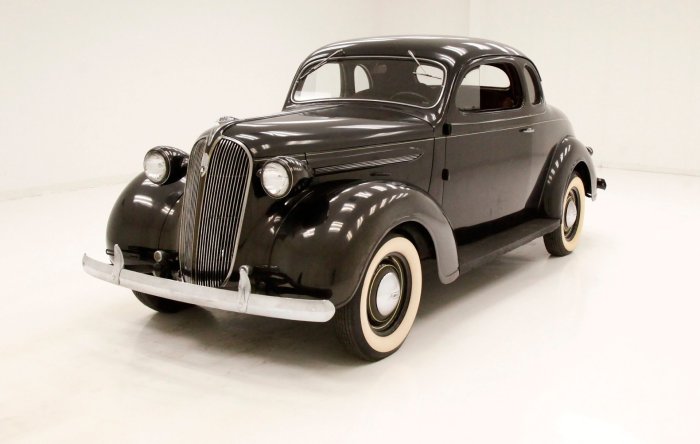
The 1937 Plymouth Deluxe emerged during a tumultuous period in American history, a time marked by both economic hardship and nascent recovery. The Great Depression, which had gripped the nation since 1929, was still casting a long shadow, though there were signs of improvement.The automotive industry, a vital sector of the American economy, had been particularly hard hit by the Depression.
Car sales plummeted, factories shut down, and unemployment soared. However, by 1937, the industry was showing signs of revival, with production levels beginning to climb.
The Impact of the Great Depression on the Car Market
The Great Depression had a profound impact on the American car market. With widespread unemployment and a decline in disposable income, consumers were forced to prioritize basic necessities over luxury items like automobiles. The following factors illustrate the impact of the Great Depression on the car market:
- Plummeting Sales:Car sales plummeted dramatically during the Depression. In 1929, Americans purchased nearly 5.4 million new cars. By 1932, that number had fallen to just over 1 million. This drastic decline reflected the economic hardship facing the nation.
- Factory Closures:Many automobile manufacturers were forced to close their factories or reduce production due to the lack of demand. This resulted in widespread unemployment within the industry.
- Shifting Consumer Preferences:Consumers who could afford to buy cars during the Depression often opted for less expensive and more fuel-efficient models. This led to a decline in demand for luxury cars and a rise in popularity for smaller, more affordable vehicles.
The Great Depression forced the automotive industry to adapt to the changing economic landscape. Manufacturers began to offer more affordable models, focus on fuel efficiency, and introduce innovative financing options to make car ownership more accessible to a wider range of consumers.
Plymouth Deluxe: 1937 Plymouth Deluxe
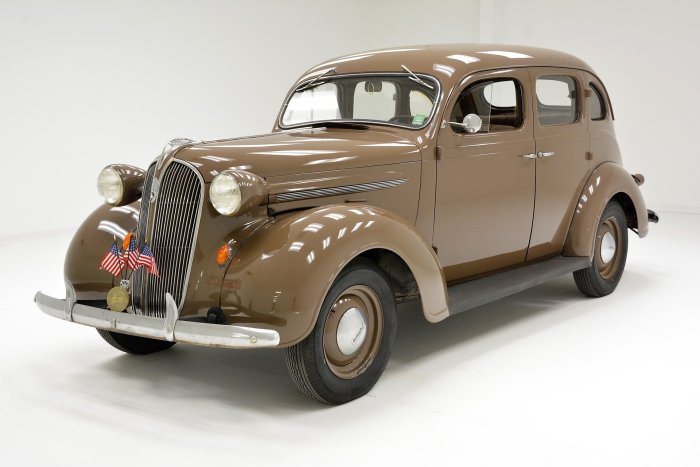
The 1937 Plymouth Deluxe, a shining example of automotive innovation, was a pivotal model for the brand and a testament to the progress of the American automotive industry. It was a significant departure from its predecessors, boasting an array of features that redefined the driving experience and cemented its place as a symbol of progress.
Design Features and Innovations
The 1937 Plymouth Deluxe represented a leap forward in automotive design. It featured a streamlined, aerodynamic body, a departure from the boxy designs of earlier cars. The car’s rounded fenders, sloping hood, and integrated grille created a more cohesive and modern aesthetic.
The Deluxe also boasted a larger, more powerful engine, offering improved performance and fuel efficiency.Beyond aesthetics, the Plymouth Deluxe incorporated several innovative features that enhanced the driving experience. These included:
- Independent front suspension:This system provided a smoother and more comfortable ride, especially on rough roads.
- Hydraulic brakes:These brakes were more responsive and reliable than the mechanical brakes used in previous models.
- Safety glass:This innovation, which was becoming increasingly common in cars of the era, helped to protect passengers in case of an accident.
The Deluxe also offered a range of comfort and convenience features, including a spacious interior, a stylish dashboard, and an array of optional extras like a radio and a heater.
Comparison with Other Cars of the Era
The 1937 Plymouth Deluxe was positioned as a mid-priced car, competing with other popular models like the Chevrolet Master Deluxe, Ford Deluxe, and the Pontiac Six. It offered a compelling combination of affordability, style, and performance, making it a strong contender in the crowded American car market.Compared to its rivals, the Plymouth Deluxe stood out for its sleek design, its comfortable interior, and its innovative features.
It was particularly well-regarded for its handling and its smooth ride, qualities that were not always found in cars of its price range.
Marketing Strategies
Plymouth employed a variety of marketing strategies to promote the Deluxe. These included:
- Targeted advertising:The company used print and radio advertising to reach potential buyers, emphasizing the car’s style, performance, and value.
- Dealer networks:Plymouth had a strong network of dealerships across the United States, which played a crucial role in showcasing the car and providing customer service.
- Publicity:The company used public relations efforts to generate positive press coverage and build brand awareness.
Plymouth also used innovative marketing tactics like offering special financing options and emphasizing the car’s safety features to appeal to a wider audience.The 1937 Plymouth Deluxe was a successful model for the brand, contributing significantly to its growth and reputation.
It exemplified the progress of the American automotive industry and became a symbol of affordability, style, and innovation.
The 1937 Plymouth Deluxe, with its Art Deco styling and powerful straight-eight engine, was a popular choice for families and businesses alike. However, the muscle car era of the 1970s brought a different kind of automotive excitement, epitomized by the 1972 Plymouth Cuda , with its aggressive design and powerful V8 engine.
While the Cuda represented a shift in automotive culture, the 1937 Plymouth Deluxe remains a testament to the enduring appeal of classic American design and engineering.
Technical Specifications
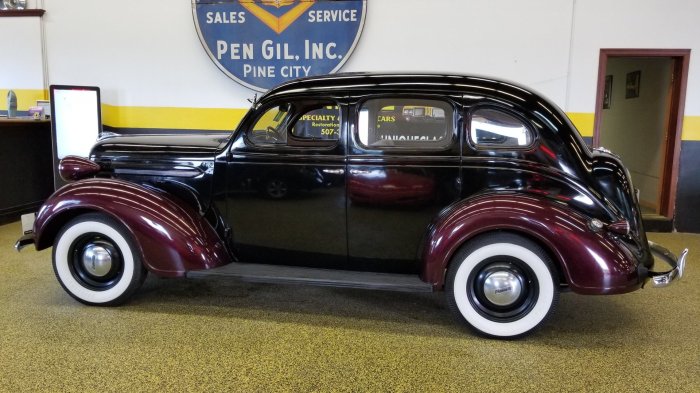
The 1937 Plymouth Deluxe, a shining example of automotive innovation, boasted a range of technical features that set it apart in the market. This section delves into the heart of the vehicle, exploring its engine, transmission, chassis, and available body styles and trim levels.
Engine and Transmission
The 1937 Plymouth Deluxe was powered by a 2.4-liter straight-six engine, generating 82 horsepower. This engine was paired with a three-speed manual transmission, which was standard across all models. The engine was known for its reliability and efficiency, providing a smooth and dependable driving experience.
The 1937 Plymouth Deluxe, with its Art Deco styling and innovative features, marked a significant shift in the automotive landscape. While the Deluxe embodied the elegance of its era, later Plymouth models, like the 1965 Plymouth Sport Fury , embraced a more muscular and performance-oriented design.
The 1937 Deluxe, however, remains a testament to Plymouth’s early commitment to affordability and style, offering a glimpse into the evolution of the brand over the decades.
Chassis
The chassis of the 1937 Plymouth Deluxe featured a sturdy ladder frame construction, ensuring durability and stability. The front suspension was a traditional independent system with coil springs, while the rear suspension employed a live axle with semi-elliptical leaf springs.
The 1937 Plymouth Deluxe, with its Art Deco styling and advanced engineering for its time, represented a shift in American automotive design. While it was a far cry from the retro-futuristic styling of the 1999 Plymouth Prowler , both vehicles showcased Plymouth’s commitment to innovative design, albeit in vastly different eras and markets.
This combination offered a comfortable ride and good handling characteristics.
Body Styles and Trim Levels
The 1937 Plymouth Deluxe was available in a variety of body styles, catering to diverse needs and preferences. These included:
- Coupe: A two-door model offering a sporty and compact design.
- Sedan: A four-door model providing ample passenger space and practicality.
- Convertible Coupe: A luxurious and stylish option with a retractable roof.
- Business Coupe: A stripped-down version designed for commercial use.
Each body style was available in multiple trim levels, ranging from basic to luxurious. These trim levels offered varying levels of features and amenities, allowing buyers to customize their vehicles according to their budget and preferences.
Key Specifications
| Specification | Value |
|---|---|
| Engine | 2.4-liter straight-six |
| Horsepower | 82 hp |
| Transmission | 3-speed manual |
| Wheelbase | 113.5 inches |
| Length | 171 inches |
| Width | 64 inches |
| Height | 58 inches |
| Curb Weight | 2,800 lbs |
Cultural Significance
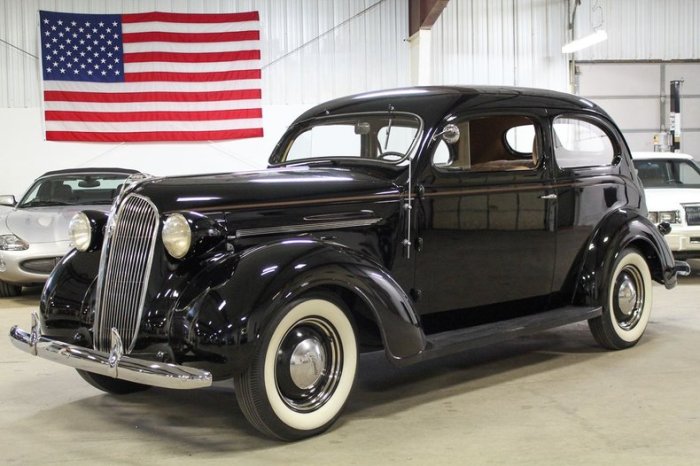
The 1937 Plymouth Deluxe, like many cars of its era, played a significant role in shaping American culture and society. Its affordability and reliability made it a symbol of the American dream, while its stylish design reflected the optimism and progress of the time.
The 1937 Plymouth Deluxe in Popular Culture
The 1937 Plymouth Deluxe was featured in numerous films, television shows, and advertisements, contributing to its widespread recognition. Its sleek design and advanced features made it a popular choice for Hollywood productions, showcasing the car’s appeal to a wider audience.
- The car appeared in the 1938 film “The Adventures of Robin Hood,” starring Errol Flynn, where it was used as a prop to depict a luxurious carriage. This association with a classic film further solidified the Plymouth Deluxe’s image as a stylish and desirable vehicle.
- The car also appeared in the 1940 film “The Grapes of Wrath,” directed by John Ford, where it symbolized the hardship and resilience of the Dust Bowl era. This portrayal showcased the car’s practicality and its ability to endure difficult conditions, reinforcing its image as a reliable and dependable vehicle.
Legacy and Impact
The 1937 Plymouth Deluxe, with its innovative design and affordability, left a lasting impact on the automotive industry. It solidified Plymouth’s position as a leading manufacturer of accessible and stylish cars, influencing subsequent models and shaping the landscape of the American automotive market.
Influence on Later Models, 1937 Plymouth Deluxe
The 1937 Plymouth Deluxe’s design elements, particularly its aerodynamic body and distinctive grille, served as inspiration for future Plymouth models. Its streamlined profile and integrated headlights set a trend for car design in the years to come. The Deluxe’s success also demonstrated the appeal of affordable luxury, prompting Plymouth to continue offering stylish and well-equipped cars at competitive prices.
Comparison with Modern Vehicles
While the 1937 Plymouth Deluxe is a product of its time, some of its core principles remain relevant in modern vehicles. Its focus on affordability and practicality is still a defining characteristic of many popular cars today. The Deluxe’s emphasis on passenger comfort and safety also resonates with modern automotive standards.
However, there are significant differences in technology, safety features, and environmental considerations. Modern cars boast advanced powertrains, electronic stability control, and sophisticated safety systems, all of which were absent in the 1937 Plymouth Deluxe.
End of Discussion
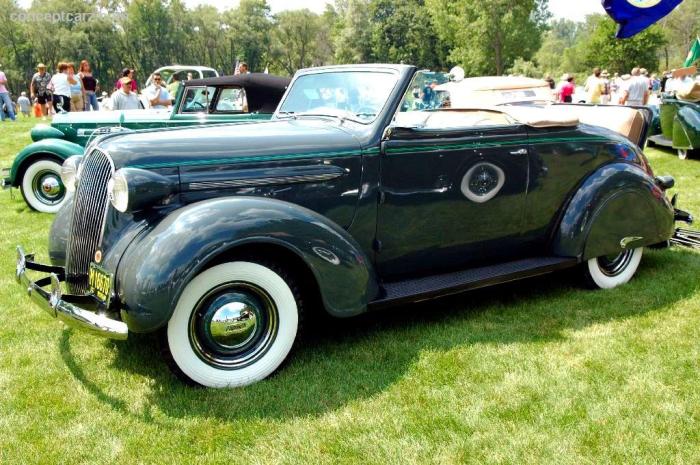
The 1937 Plymouth Deluxe remains a significant chapter in automotive history, not only for its impact on the industry but also for its enduring cultural significance. It serves as a reminder of a time when America was rebuilding and finding its footing, and the car itself embodied that spirit of renewal.
Its influence can still be seen in the design and engineering of modern vehicles, demonstrating the enduring legacy of this iconic automobile.